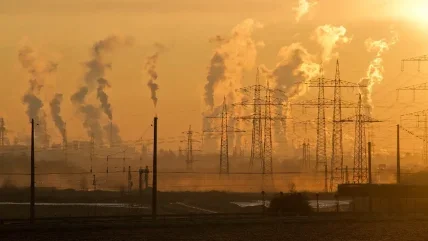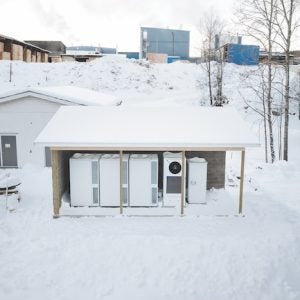
Diesel gensets are relied upon to provide emergency backup in a broad range of applications. They offer reliability and high performance, starting up quickly, in 10 seconds or less, to provide a guaranteed source of electricity when needed.
Diesel generators also offer a low total cost of ownership. The latest designs have been optimised for fuel efficiency and reduced maintenance needs. They are supported by a well-established fuel supply infrastructure to underpin continuity of operation.
So, diesel gensets are seen as workhorses. But there is a challenge. The climate crisis means that all organisations are under significant pressure to comply with environmental regulations and to achieve corporate sustainability goals. Anything that uses fossil fuels will, rightly, be subject to increased scrutiny, to see how its emissions can be reduced.
Diesel generators are in this category. So how can their emissions be minimised to reduce environmental impact while maintaining resilient power supply?
Critical factors for generator deployment
The first consideration when selecting a genset is to understand its application fully. It might be covering power outages and planned maintenance, managing grid instability and meeting peak demand. It could also be used to support the integration of renewables, and other applications.
Once the application for the generator has been understood, and the requirements for how much power is needed, a good next step is to review regional regulations.
For the USA, installations are regulated by the EPA. The EPA Tier 4* requirements have made good progress in reducing emissions, and pockets of specific air quality management districts (AQMD) with stricter regulations are also emerging. This includes California, Virginia, and other areas of the east coast. It’s key to understand those local regulations and pick a technology that will meet the specific requirements in that area.
In the EU, there are similar requirements for emissions, including Stage V. The MCPD (Medium Combustion Plant Directive)** aims to reduce harmful emissions such as NOx from gensets and other mid-size equipment (rated between 1 MWt and 50 MWt). The directive is adapted (transposed) to each individual country.
Another important factor is that operators simply want to be better. They want to provide the greenest solution or use the best available technology, and go beyond what the legislation demands, for example by adding an additional after-treatment system to their genset.
Once the role of the genset has been fully analysed and the applicable environmental legislation fully assessed, viable options for reducing emissions, if required, can be reviewed. Let’s look at a few technologies that can help.
HVO: a renewable fuel
One of the biggest opportunities to reduce generator emissions is by switching from fossil diesel to renewable fuel. In particular, hydrotreated vegetable oil (HVO) can provide an effective alternative to diesel, which can help reduce overall greenhouse gas emissions.
HVO is usually made by the hydrogenation of vegetable oil, or by hydrocracking. Also known as green diesel or renewable diesel, using HVO instead of conventional diesel reduces net CO2 emissions by up to 90%.
Since HVO is similar in grade and quality to conventional diesel, it can be used without modification of infrastructure, or any need to buy new engines. It is compatible with the standard mix of petroleum-derived diesel fuels, so it can also be blended with fossil diesel – thus increasing flexibility for the end-user. It is easy to store and handle and can be kept for years without major degradation.
HVO is made from waste products and residues that don’t impact agricultural land use, including vegetable oils, animal fats, and used cooking oils. It could also be made from photosynthetic organisms such as algae in the near-to-medium term.
Compared to traditional first-generation biofuels, HVO is also a superior, cleaner-burning fuel, which helps reduce emissions across its lifecycle. The generator transient response time when using HVO is also similar to the performance achieved with conventional diesel, meaning the genset can respond quickly enough when called upon. HVO is more costly than traditional diesel, but prices are expected to drop.
So, by how much can HVO reduce CO2 emissions? Fossil diesel produces about 0.75 kg of carbon dioxide per kWh produced by a genset. The corresponding figure for an HVO fuelled genset is about 0.08 kg/kWh.
Other technologies
In the development phases of genset projects, there are naturally trade-offs involving emissions reductions, to ensure everything is being done to optimise emissions specifically for each application.
This typically starts with in-cylinder technologies such as EGR (exhaust gas recirculation) and combustion optimisation to ensure that the most efficient use of the engine is being achieved.
When addressing more stringent emissions requirements, options involving additional equipment may need to be considered, such as selective catalytic reduction (SCR) and diesel exhaust fluid (DEF), which can reduce NOx emissions to negligible levels.
Adding these extra technologies typically does involve additional cost, and also comes with regulations to be complied with and specific protections that the engine must have to ensure that the emissions equipment is properly functioning.
Optimising maintenance schedules
Gensets for emergency standby power spend most of their life sitting idle waiting for there to be an outage. To ensure that they’re constantly ready, they need maintenance, which includes being run regularly to check everything is working. Traditionally, this check is run with load to reduce ‘wet stacking’ – which is when unburned fuel builds up in the engine’s exhaust system, leading to excessive wear and damage.
To continue to reduce the cost of ownership and lower emissions, genset manufacturers are working to reduce the number of hours running needed each year for maintenance, as well as reducing the loads needed. The latest sustainable maintenance programmes allow certain gensets to do the monthly maintenance run with no load present and with an extended exercise interval, reducing annual genset emissions by up to 69% (compared with the emissions when running maintenance exercises at 30% load).
Maintaining performance and economics
By taking a pragmatic approach, as outlined above, users of diesel gensets can minimise their emissions, but without noticeable cost increases and performance impairments.
Independence for Kohler Energy
In November 2023 Kohler Co announced it had taken the strategic decision to set Kohler Energy up as a separate, independent business, with Platinum Equity engaged as the majority investment partner and Kohler continuing to stay invested in the Energy business following the closing.
The Kohler energy resilience business portfolio included in the transaction consists of Power Systems, Engines, Home Energy, Kohler Uninterruptible Power, Clarke Energy, Curtis Instruments, and Heila Technologies.
The transaction is expected to close in the first half of 2024. Until then, Kohler Co will continue to operate as one company.
David Kohler, Chair and CEO of Kohler, who will also be on the board of Kohler Energy, said the move signified a “commitment to deepening the focus and investment in Kohler’s Kitchen & Bath and Hospitality businesses”, noting that “the timing is right due to the strength of the Energy business.”
Brian Melka will serve as CEO of the Energy business.
Platinum Equity is a global investment firm with approximately $47 billion of assets under management, a successful track record in carve-out transactions and “28 years of experience acquiring and operating global businesses that have been part of large corporate entities.”
A few days after the announcement from Kohler Co establishing Kohler Energy as an independent company, Kohler Energy launched a new hydrogen fuelled engine and its first-ever hydrogen fuel cell power system (pictured above).
Alongside its activities in the HVO and e-fuels area, this reflects Kohler Energy’s strategy of providing a broad range of clean energy and hydrogen-ready technologies for off-highway equipment and standby and prime power applications for residential and industrial applications, in the power range from 20 kW to 5 MW+.
“We believe we can provide the broadest array of solutions, especially in hydrogen, given our unique footprint across diverse end markets,” said Brian Melka.
Kohler Energy’s first fuel cell based power generating unit is a 100 kW solid polymer electrolyte membrane system using green hydrogen, designed for emergency backup, peak shaving and demand response.
The system is considered suitable for a broad range of mission-critical applications, eg in hospitals, data centres, ports and water treatment plants.
Author: Nicole Dierksheide Director of Large Engine Power Systems, Kohler






